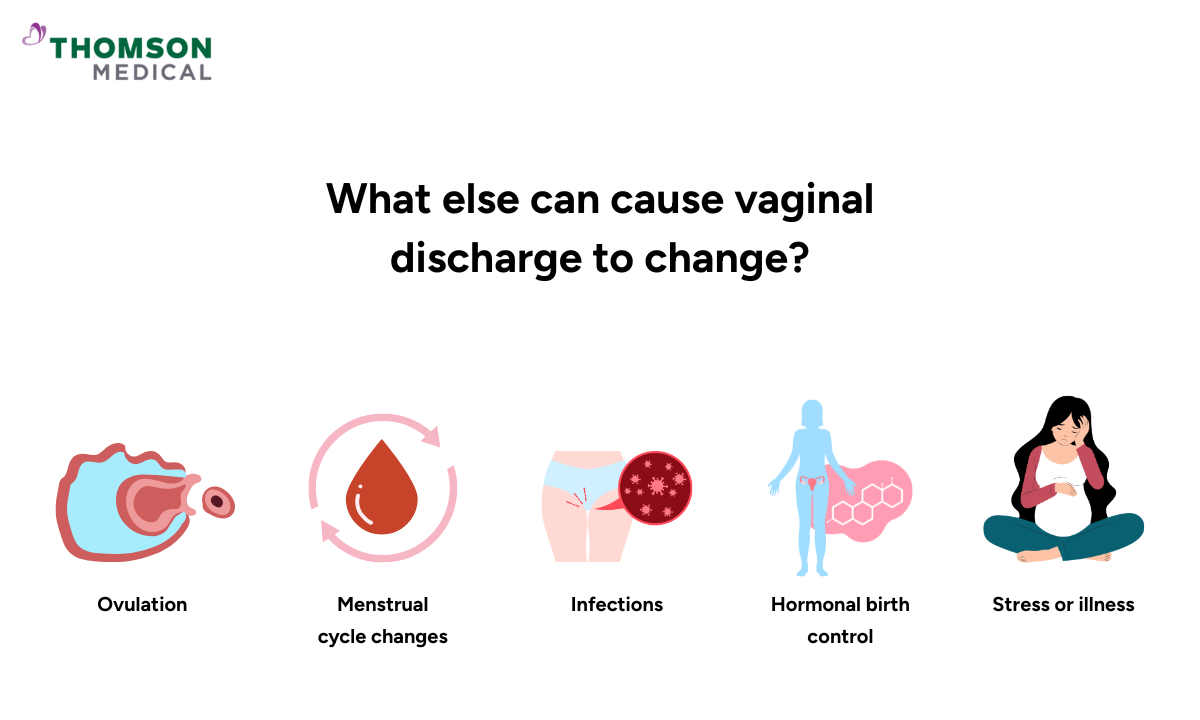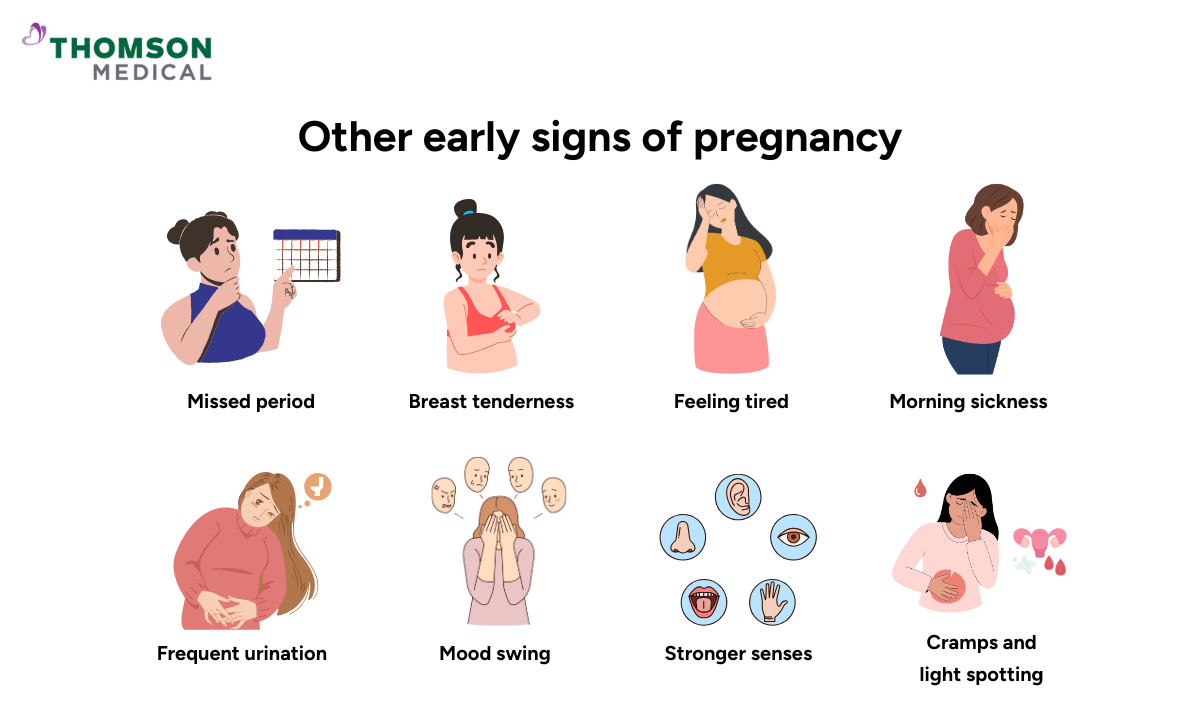For many women, one of the first signs of pregnancy within days or weeks of conception is a shift in their vaginal discharge, also known as early pregnancy discharge.
This change can happen even before a missed period or other pregnancy symptoms appear. While it might feel unusual or a bit worrying, this early change is completely normal and often one of your body's earliest responses to pregnancy.
What is early pregnancy discharge?
Early pregnancy discharge refers to the changes in vaginal secretions that happen during the first few weeks after conception. This type of discharge, known as leukorrhoea, becomes more noticeable due to the sudden hormonal shifts—especially in oestrogen and progesterone—that occur right after pregnancy begins.
Unlike the regular discharge you may experience throughout your menstrual cycle, this increase in leukorrhoea is a direct response to conception. These changes can start just days after fertilisation and are often one of the earliest signs that pregnancy has occurred.
What does early pregnancy discharge look like?
Every woman is different, but common features of early pregnancy discharge include:
For many women, one of the first signs of pregnancy within days or weeks of conception is a shift in their vaginal discharge, also known as early pregnancy discharge.
Colour:
Typically, early pregnancy discharge is white or slightly cloudy. This change is due to hormonal fluctuations, particularly the increase in oestrogen levels.
Texture:
The texture is often described as thin, creamy, or slightly sticky. This is a result of the increased blood flow and hormonal changes in the body.
Smell:
Usually, early pregnancy discharge has a mild or odourless scent. A strong or unpleasant odour could indicate an infection and should be checked by a healthcare provider.
Amount:
Many women notice an increase in the amount of discharge during early pregnancy. It tends to be more continuous than usual.
Some women may also experience light pink or brown spotting during the very early stages of pregnancy. This spotting can be related to implantation bleeding, which occurs when the fertilised egg attaches to the lining of the uterus.
If you have concerns about the colour, smell, or amount of discharge, or if you experience heavy vaginal bleeding, you can request an appointment with Thomson Women’s Clinic for further guidance.
How soon does discharge start in early pregnancy?
One of the earliest signs of pregnancy can be changes in vaginal discharge. These changes happen as your body adjusts to rising hormone levels after conception. Here’s a simple timeline of what to expect:
6–12 days after conception:
Some women notice the first changes in discharge, often before other pregnancy symptoms appear.
1–2 weeks after conception:
Vaginal discharge usually increases as hormone levels rise.
Before a missed period:
Many women can already detect changes in discharge.
2–4 weeks after conception:
Discharge often becomes more noticeable and consistent.
Why does it happen so early?
Even before you miss a period just a week or two after conception, your body begins to go through some remarkable changes. Hormones like oestrogen and progesterone start rising rapidly, laying the groundwork for a healthy pregnancy. This early hormonal surge supports your body in several important ways:
Increases blood flow to the pelvic area
Stimulates the cervix to produce more mucus
Helps create the protective environment your body needs for early pregnancy
Begins forming what will eventually become the mucus plug
The increase in vaginal discharge is completely normal and actually plays a protective role. It helps keep harmful bacteria out and maintains the balance your body needs during the early stages of pregnancy.
What else can cause vaginal discharge to change?

Vaginal discharge doesn’t always mean you’re pregnant. It can change for many other reasons, most of which are completely normal. Everyday factors like hormones, health, and even your mood can affect how it looks, smells, or feels. Here are some common causes of why discharge changes:
Ovulation:
Around the middle of your menstrual cycle, you might notice your discharge becomes clear, slippery, and stretchy—kind of like raw egg whites. This is a natural sign your body is ovulating.
Menstrual cycle changes:
Hormone levels rise and fall throughout your cycle, which can make your discharge thicker, thinner, or more watery depending on the time of the month.
Infections:
A yeast infection often leads to thick, white discharge that looks a bit like cottage cheese and may come with itching or irritation.
Bacterial vaginosis (BV) usually causes a thin, grey discharge that has a strong, fishy smell.
Sexual arousal:
When you’re sexually aroused, it’s normal to have a clearer, slippery discharge. It’s just your body’s natural way of helping with comfort during intimacy.
Hormonal birth control:
Using methods like the pill, patch, or an IUD can affect the amount and texture of your discharge. These changes are usually harmless and related to how birth control affects your hormones.
Stress or illness:
When you’re stressed out or feeling unwell, your hormone balance can shift, which might also lead to changes in your vaginal discharge.
Other early signs of pregnancy

Along with changes in vaginal discharge, many women experience a variety of other early pregnancy symptoms. These can differ from person to person, but some of the most common signs include:
Missed period:
Often the first and most obvious early pregnancy sign.
Breast tenderness:
Hormonal changes can make breasts feel sore, sensitive, or fuller than usual.
Feeling tired:
You might find yourself needing more rest than usual, especially in the early weeks.
Nausea:
Sometimes with vomiting, sometimes without—commonly known as morning sickness, though it can happen at any time of day.
More frequent urination:
You may notice you're heading to the bathroom more often.
Mood swings:
Emotional ups and downs are common, thanks to hormone shifts.
Stronger senses:
You might suddenly become more sensitive to smells or notice changes in how things taste.
Mild cramps or bloating:
Some women feel slight abdominal discomfort that can be mistaken for period cramps.
Light spotting:
A small amount of pink or brown spotting, known as implantation bleeding, can occur when the fertilised egg attaches to the uterus.
Not sure if your symptoms could mean you're pregnant? Request an appointment with Thomson Women’s Clinic for a proper check-up and peace of mind.
How to manage vaginal discharge during pregnancy?
Experiencing more vaginal discharge during pregnancy is completely normal, but it’s important to stay clean and comfortable. Here are some simple, safe ways to manage it:
Keep up with good hygiene by gently washing your intimate area daily using warm water and a mild, unscented soap
Choose breathable cotton underwear to promote airflow and reduce irritation
Change your underwear if it becomes damp or uncomfortable
Use unscented panty liners for extra protection, but avoid tampons during pregnancy
Stay well hydrated and eat a nutritious, balanced diet to support overall vaginal health
Avoid douching or scented feminine products, as they can disrupt the natural balance of bacteria and cause irritation
These tips can help you feel fresh, reduce discomfort, and lower the risk of infections during pregnancy.
When to see a doctor
While most vaginal discharge in pregnancy is harmless, there are times when it may be a sign of something more serious. Contact your doctor or healthcare provider if your discharge:
Turns yellow, green, or gray in color
Has a strong, unpleasant odor
Comes with itching, burning, swelling, or redness around the vaginal area
Is very watery and continuous, especially in later pregnancy (this could be a sign of amniotic fluid leakage)
Contains blood, especially after a confirmed pregnancy
Is accompanied by pelvic pain, cramps, or fever
Such symptoms could indicate an infection, irritation, or other health concerns that may need medical attention. It’s always best to check with your doctor if something feels off.
Our O&G specialists
Loading...
FAQ
What does early pregnancy discharge look like?
Early pregnancy discharge is often thin, white or milky, and either creamy in texture or slightly watery. It’s typically odourless or has only a mild scent. This discharge, known as leukorrhoea, is common in early pregnancy.
Can discharge tell me if I’m pregnant?
While changes in discharge may provide a hint, they are not enough to confirm pregnancy on their own. Other hormonal shifts can cause similar changes. A pregnancy test remains the most reliable method of confirmation.
Are there 100% certain signs of pregnancy in the first week?
There are no completely certain signs during the very first week. In fact, implantation often hasn’t even occurred yet. The most dependable confirmation comes from a positive pregnancy test, usually accurate 10 to 14 days after ovulation.
What are the earliest signs of pregnancy?
Some common early signs include light spotting (implantation bleeding), fatigue, sore or tender breasts, nausea, more frequent urination, and mild cramping. A missed period, followed by a positive pregnancy test, is the clearest indication.
How can I know when I conceived?
Conception timing can be estimated by tracking ovulation or counting from the first day of your last menstrual period (LMP). An early pregnancy ultrasound can also help narrow down the likely date of conception.
What is the difference between menstrual discharge and pregnancy discharge?
Menstrual discharge contains blood and tissue, while pregnancy discharge is usually white or milky, thin or creamy, and not bloody.
The information provided is intended for general guidance only and should not be considered medical advice. For personalised recommendations and tailored advice, please consult a specialist at Thomson Medical. Request an appointment with Thomson Medical today.
For more information, contact us:
Thomson Specialists (Women's Health)
Thomson Women's Clinic (TWC)
- Novena:
6592 6686 (Call), 8611 8986 (WA) - Bukit Batok:
6569 0668 (Call), 8686 3525 (WA) - Choa Chu Kang:
6893 1227 (Call), 8282 1796 (WA) Jurong:
6262 8588 (Call), 6262 8588 (WA)- Katong (female doctor):
6970 2272 (Call), 8611 9020 (WA) - Punggol:
6243 6843 (Call), 8811 0328 (WA) - Sembawang: 6753 5228
- Sengkang: 6388 8125
- Serangoon (female doctor): 6382 3313
- Tampines: 6857 6266
- Tiong Bahru: 6276 1525
